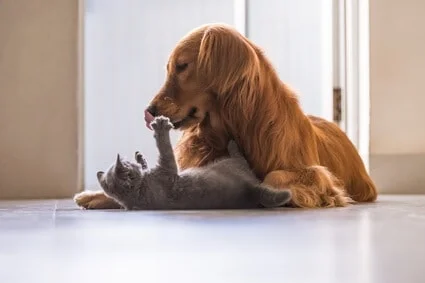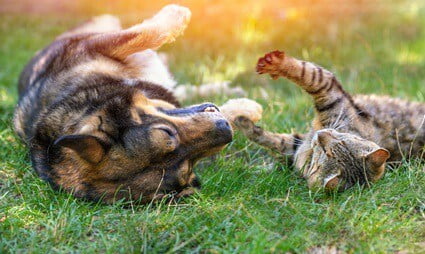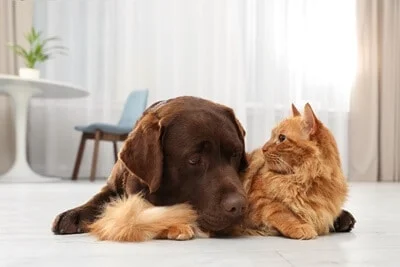Cats and dogs make different sounds, have different personalities, and move differently. When you introduce a cat to a dog, they may be hesitant about each other, leaving owners wondering if the real issue is communication. Cats meow and dogs bark, so it can seem like they lack a shared language.
Through body language, dogs and cats communicate their moods, feelings, and intentions. This lets each animal know if the other feels agitated, angry, scared, friendly, playful, or accepting of company. It’s not the same as a detailed verbal conversation, but it provides a basic understanding.
Cats and dogs often have different body language, leading to misunderstandings. For example, signs of playfulness for a cat might translate into signs of illness or pain for a dog. A closed mouth can mean tension in a dog but peacefulness in a cat.
Do Cats And Dogs Understand Each Other?
Cats and dogs do understand each other, but not perfectly.
They cannot communicate with each other as clearly as they can with members of their species. However, this doesn’t seem to inhibit their ability to communicate.
Meowing or barking are not interchangeable animal languages. Even their body language can be different, leading to misunderstandings between cats and dogs.
In a basic sense, dogs and cats can understand each other as well as humans understand either animal. That’s because basic intentions and reactions aren’t hard to communicate.
For example, a cat’s hissing, scratching, and yowling are odd and alarming sounds to humans and dogs. A dog will realize that your cat isn’t pleased with it.
Likewise, a bark, growl, or bite are all signs of aggression that your cat will understand. Even though it doesn’t bark itself, it will know that it’s not a friendly gesture. It deduces this mostly from how stark the action is and what body language accompanies it.
Can Cats And Dogs Be Friends?
Cats and dogs aren’t inherent enemies, and many become friendly when kept as pets. That’s because basic intentions are usually the most any cat or dog will want to know about the other animal.
Simple questions can be answered with a broad range of body language, such as:
- Do you want to hurt me?
- Can I sleep here?
- Are you interested in playing?
- Do you want to be friendly?
- Can I have some of your food?
For this reason, it doesn’t matter if your dog or cat understands the nuance in the request or can offer nuance in its response. The animal gets the idea, and that’ll suffice.
Cats and dogs are capable of basic learning, which means that they will come to understand each other better after spending more time around one another.
For example, a random cat and dog meeting each other may be hesitant and confused for the first time. Misunderstandings can lead to conflict and aggression.
However, they’ll know each other’s preferences, mannerisms, and personalities after several years as companions. For example, it’ll be easier for your dog to understand your cat’s no to playtime without needing to be hissed at.
According to Applied Animal Behavior Science, dogs and cats are more likely to cohabit harmoniously when they’re introduced at a young age.
Can Cats and Dogs Talk To Each Other?
Cats and dogs cannot talk to each other as they can’t develop and understand languages.
What allows humans to understand languages is an area of the brain known as Wernicke’s area. Scientists have looked for a similar area in cats and dogs but have failed to find one. This means that cats and dogs cannot talk, even if meowing or barking seems like it.
Both animals are smart, but it’s not them understanding a language when they react to sounds. They’re just reacting based on how they were conditioned to react.
For example, a dog that has been around a cat for a long time will learn to associate certain meows from the cat with certain moods. This means that the dog has adapted to the cats’ behavior.
Do Cat Meows Mean Anything?
Cats often use vocalization to communicate with their owners. To us, it seems like they’re talking, but in truth, they aren’t saying anything.
Cats meows don’t mean anything because cats are incapable of understanding languages. Cats don’t meow at each other because they don’t need to.
They communicate using body language and smells. The reason they meow at us is that they’ve learned that it’s the best way to gain our attention and get what they want.
Why Does My Cat Meow at My Dog?
Cats don’t communicate with dogs through meows. In truth, it’s more likely that your cat is meowing at you instead. If your cat only does this when you’re in the same room, it’s trying to tell you something.
If it doesn’t look at you while meowing, it may want to keep its eyes on the dog while it calls you over. The cat feels intrigued or intimidated by the dog.
Likewise, your cat may not be meowing at all. Sometimes, cats yowl, and it can sound like a long meow. Yowling usually means that the cat is distressed, so it’s not a good sign. If your cat yowls at your dog, it may feel scared.
Cats don’t meow at dogs because dogs communicate primarily through body language. Humans rarely pick up on body language cues; cats understand that vocalization is the best way to talk to us.
When in the presence of a cat, dogs give off certain cues instinctively, such as tail wagging and raising their ears. Cats pick up on these cues and understand that communicating with dogs through body language is more convenient than meowing.

Why Do Dogs Bark at Cats?
Unlike cats, dogs communicate through vocalization as well as body language. Dogs have been with us since our hunter-gatherer days, where they helped warn us of dangers.
This trait of barking to catch our attention is a consequence of domestication, and that’s proven by the fact that wild wolves don’t bark.
However, cats haven’t been properly domesticated, so their meowing doesn’t carry over into cat-to-cat communication. Adult cats don’t meow at each other.
Your dog is more likely to bark at your cat for the following reasons:
- Instigating playtime
- Threatening it
- Alerting it of something
- Expressing happiness
It’s more likely for a puppy to communicate with cats via barking than adult dogs. Dogs are more capable of adapting to cat behavior. Once the dog learns that using body language around a cat is more efficient, it might not bark as much.
Cat vs. Dog Body Language
Cats and dogs have different physical cues. If the two animals don’t know each other, this can lead to misinterpreting innocent gestures for aggression.
It’s also a dog’s instinct to chase small animals, while cats are naturally distrusting and cautious. Add in a lack of understanding of physical cues and you can get conflict between the two animals.
Body language differences include:
| Body Language | Cat | Dog |
|---|---|---|
| Arched Back | Afraid/Playing | In Pain |
| Closed Mouth | Relaxed | Tense/Stressed |
| Tail Wagging | Annoyed/Angry | Happy |
| Baring Teeth | Aggressive/Threatening | Friendly/Happy |
| Upwards Tail (Not Wagging) | Happy/Content | Possible Illness |
As the above table shows, there are many ways a cat and dog can misunderstand each other. However, they do share some physical cues, such as:
| Body Language | Meaning |
|---|---|
| Tail Tucked Between Legs | Scared |
| Dilated Pupils | About to Attack |
| Exposed Belly | Trusting |
| Low Tail | Tense |
| Ears Flattened | Scared |
| Stiff Whiskers | Alert |
Why Do Cats and Dogs Fight?
Cats and dogs aren’t always enemies, but certain factors put them at odds.
They have different body language cues, and this causes misunderstanding. Dogs have been domesticated long term, so they tend to be more trusting and react positively to certain stimuli. Cats are skittish and still maintain their wild instincts since they aren’t fully domesticated.
These factors can cause fights to break out easily between the two animals, even when one of them isn’t aggressive. Usually, dogs are more sociable, so they start the interaction off with playfulness.
Cats are reserved and don’t enjoy being presented with large bursts of energy. They get startled easily, so they might perceive the dog’s cheerfulness for aggression.
When cats and dogs with vastly different personalities live together, the fighting tends to get more frequent and more aggressive as time goes on. Having a roommate with mismatched energies can stress both animals, leading to frustration and increased hostility.
Why Does My Cat Slap My Dog?
Cats communicate in many different ways that don’t involve vocalization. A cat slapping a dog can have three possible meanings, and they all depend on the context:
Playful Slapping
Cats use their paws to play, so there’s a good chance your cat and dog are just roughhousing. Look at the body language of both pets when the cat strikes, as this will indicate if it’s all in good fun.
Body language that indicates that the cat is playing includes:
- Ears pointed forward
- Retracted claws
- Relaxed posture
- Lack of hissing
- Sleek tail
- Not hiding
- No running away
- Soft slaps
- Rolling on its back
Neutral/Warning Slapping
Your cat might slap your dog to reject playtime. Some dogs will engage by drawing in close and mimicking a nudge at the cat with their snout. If the dog gets too close, the cat might slap the dog until it understands that it wants to be left alone.
A rejection slap doesn’t mean that the cat is angry at the dog; it’s just a way to communicate its feelings. These are usually only 1-2 slaps until the dog goes away.
Depending on your cat’s personality and temper, this might escalate. If the dog returns before the cat is ready to socialize, the cat might slap again, walk away, or begin a fight.
Aggressive Slapping
Aggression can happen right away or in the middle of a game. This is true even if the pets are on good terms and have never hurt each other before.
Their instincts could kick in and misinterpret the other’s body language in the middle of playing around. This is especially true for cats, which get startled and overstimulated easily.
Signs of aggression in the cat include:
- Flattened ears
- Hissing
- Tucked tail
- Dilated pupils
- Claws out
- Yowling
- Shrieking
- Frantic running
- Puffy tail
- Raised fur
- Arched back
Dog Body Language Around Cats
The way your dog behaves around a cat depends on:
- Its personality
- The circumstances
- Its’ comfort level around cats
- The cat itself
If it’s the first time a dog meets a cat, these signs mean the introduction is going smoothly.
Wagging Tail
This means that the dog is relaxed and happy. Ensure that the dog isn’t too excited, as its overwhelming cheerfulness could upset the cat.
Tail Low And Avoiding Eye Contact
This indicates that the dog is nervous. It might not be scared, but it’s confused by the situation and might avoid getting closer to the cat.
Comfort the dog if it’s nervous so that it doesn’t associate the cat with a negative feeling.
Cowering, Tucked Tail, And Whimpering
The dog is scared, so you need to be careful and step in because fear can turn into aggression quickly.
Growling, Excessive Barking, Teeth Bared, Open Stance
The dog is aggressive and about to attack the cat., so you need to act fast and separate the two animals before they get hurt.
Cat Body Language Around Dogs
Watch your cat’s body language when it first meets the dog. Even if the dog is reacting positively, if the cat isn’t, it could make the cat associate the dog with a negative experience.
This might tarnish any potential relationship they could have formed. That’s especially true because cats don’t forgive and forget easily.
Laying Down, Raised Tail, Mouth And Eyes Closed
This means that the cat is relaxed and comfortable. It’s not troubled by the dog’s presence and feels safe enough to ignore it.
Ears Sideways, Tail Low, Dilated Pupils
The cat is nervous. It may not be scared yet, but it is alert and distrustful.
Crouching, Tucked Tail, Possible Yowling
The cat is scared. The yowl is a warning that it will attack if the dog gets too close. Cats are erratic when they are scared, so it’s best to get the dog away from it. Leave the cat alone, as it’s more likely to attack you when scared.
Hissing, Body Low, Swinging Paw, Flat Ears
The cat is on the defensive, but it’s close to striking. Cats don’t always attack first, but one wrong move can make it lunge.
How Can I Make Sure a Cat and Dog Get Along?
After establishing that the cat and dog are used to each other, you need to monitor both pets. While they can be friends, it will depend on:
Age
Some dogs have less patience the older they get. An affectionate cat might get slapped if the dog gets annoyed.
Illness
Illness can change the personality or patience levels of a dog and cat. At the least, when sick, cats and dogs aren’t as active. The other pet might not understand this, leading to miscommunication.
Surprises
As mentioned, playtime between cats and dogs can escalate quickly. If either pet gets startled by a loud noise, it could get agitated enough to attack each other. After all, years of friendships between dogs and cats cannot erase their animal instincts.
Stress
Changes in routine can bring about stress for both pets. This can be a new home, renovations, a baby, or a new pet. This stress can lead to shorter tempers in both animals, causing hostility that was never present before.

Why Do Cats and Dogs Touch Noses?
There are three reasons why your cat and dog touch noses, all of them are friendly.
Saying Hello
Nose-touching is a common greeting ritual for many animals.
Cats engage in nose-touching with each other far more than dogs do. However, it’s not uncommon to see dogs touch noses, which indicates that the two animals like each other.
Teaching The Cat To Communicate
Adult dogs are more likely to touch noses with puppies than with other adult dogs.
It’s a vital part of socialization, so the dog may do this because it considers the cat a puppy, wanting it to learn how to communicate.
Smelling For Food
They could just be smelling each other’s breath to see what tasty food they have eaten. Dogs are more likely to do this with each other than cats.
Cats and dogs do communicate with each other but in a limited capacity. They rely on body language and experience to deduce basic intentions.
It’s not the same as speaking the same language, and misunderstandings happen. However, cats and dogs can learn about and understand each other with time.

